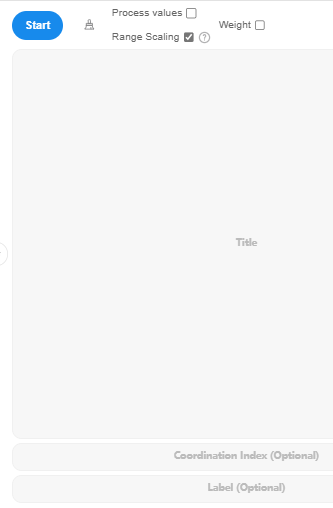Coupling Coordination Degree
Coupling is a model used to assess the degree of coordinated development between systems. It is located in SPSSAU -> Comprehensive Evaluation -> Coupling.
SPSSAU Operations

Drag the analysis items to the right box and click 'Start' to proceed. If a separate coordination index dataset is available, it can be dragged into the 'Coordination Index' box. The research objects can also be dragged into the 'Label' box. SPSSAU involves three parameters: saving calculated values, indicator weights, and data intervalization.
Saving Calculated Values: When this parameter is selected, SPSSAU will save four values—Coupling Degree (C), Coordination Index (T), Coupling Coordination Degree (D), and Coordination Level—under new titles. The titles will be named similarly to “Coupling_C_****”, “Coupling_T_****”, “Coupling_D_****”, “Coupling_Rank_****”.
Indicator Weights: This parameter is used when calculating T. SPSSAU will normalize the input weights by default. If no weight information is provided, all analysis items are assigned equal weights by default.
Data Intervalization: This parameter is selected by default. Each column's data will be scaled within the range of 0.01 to 0.99.
Note:
Researchers can also perform data intervalization through SPSSAU -> Data Processing -> Generate Variables.
SPSSAU Data Format

Coupling Coordination Degree examines the coupling coordination between different systems. Each column represents data for a system, and each row represents a research object. If a coordination coefficient is provided, it should be placed in a separate column.
Algorithm
1.Data Preparation
First, determine the indicator data that reflects the system development level. Suppose there are n systems, denoted as x1,x2,...,xn.
2.Indicator Normalization
Since indicators may have different units, normalization may be required. One common method is range standardization:
xij is the normalized indicator value, xij is the original indicator value, and max{xj} and min{xj} are the maximum and minimum values of indicator j, respectively.
Note:
There are various dimensionalization methods such as standardization, positive transformation, and negative transformation. These can be set up in SPSSAU -> Data Processing -> Generate Variables. SPSSAU does not include this step in its algorithm.
3.Calculate Coupling Degree (C)
C reflects the degree of correlation between systems. The calculation formula is:
For two systems, the formula is:
U1 and U2 are the data of the two systems.
4.Calculate Coordination Index (T)
T reflects the degree of coordinated development between systems. The formula is:
T = β1 × U1 + β2 × U2 + β3 × U3 + ... + βn × Un
β represents the system weight and U represents the system data. If all system weights are equal, β = 1 / n, where n is the number of systems. If custom weights are set by researchers, those weights take precedence, and SPSSAU will automatically normalize them. If a coordination index is provided in the analysis, SPSSAU will use the provided index instead of recalculating it.
5.Calculate Coupling Coordination Degree (D)
D comprehensively considers the coupling degree and coordination index. The formula is:
C × T must not be less than 0. For this reason, C and T should generally be greater than 0 to ensure the proper calculation of D. Both C and T are derived from system data, so preprocessing is often necessary to ensure values are positive to avoid calculation errors.
6.Calculate Coordination Level
Based on the calculated D, the level of system coordination can be assessed. A higher D value indicates a higher degree of coordinated development between the subsystems. SPSSAU provides classification standards for coordination levels, as shown in the table below:
| Standards for Coupling Coordination Degree Classification | ||
|---|---|---|
| Coupling Coordination Degree (D) Range | Coordination Level | Coupling Coordination Degree (D) |
| [0.0~0.1) | 1 | Extremely Imbalanced |
| [0.1~0.2) | 2 | Seriously Imbalanced |
| [0.2~0.3) | 3 | Moderately Imbalanced |
| [0.3~0.4) | 4 | Slightly Imbalanced |
| [0.4~0.5) | 5 | Borderline Imbalanced |
| [0.5~0.6) | 6 | Reluctant Coordination |
| [0.6~0.7) | 7 | Primary Coordination |
| [0.7~0.8) | 8 | Intermediate Coordination |
| [0.8~0.9) | 9 | Good Coordination |
| [0.9~1.0] | 10 | High-quality Coordination |
References
【1】The SPSSAU project (2024). SPSSAU. (Version 24.0) [Online Application Software]. Retrieved from https://www.spssau.com.
【2】周俊,马世澎. SPSSAU科研数据分析方法与应用.第1版[M]. 电子工业出版社,2024.
【3】丛晓男. 耦合度模型的形式、性质及在地理学中的若干误用[J]. 经济地理, 2019(4).